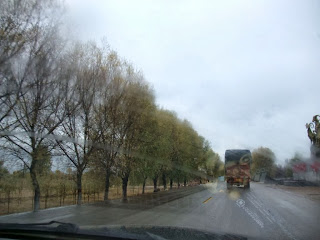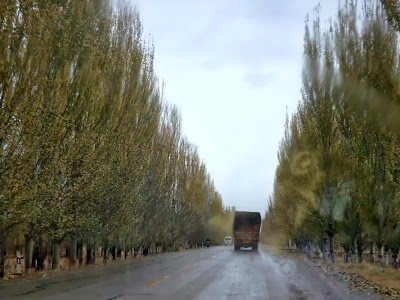
The phenomenal Sakyamuni Pagoda (释迦塔) of Temple Fogong-si (佛宫寺), 85km away south of Datong City, is the tallest and oldest wooden structure in China, and most probably was the first pagoda built in the world. It was said that the 67 meter high pagoda was built by Emperor Daozong of Kitan-led Liao Dynasty in year 1056 at Ying County, the homeland of his grandmother. According to Kitan's customs, Yelu Clan sons had to be raised within families of their mother and Yingzhou, was the place where Emperor Daozong, a devout Buddhist, spent his childhood. The town was a battlefield at that time and building a Pagoda was not only to propagate Buddhism, to bless people but also act as a watch tower to avoid the sudden attack or infiltration of enemy. Basing on records, some repairs were done in year 1195 and 1471 in Ming Dynasty, during when people believed that the pagoda built in year 1056 was funded and erected by a monk named Tian.



Sakyamuni Pagoda is regarded as a gem in the architectural field. It shares the same fame as the Pisa Tower of Italy and Eiffel Tower of Paris. The unique octagon structure features 54 different kinds of bracket arms and jointed only by tenors and mortises without a single nail or rivet in its construction. Externally, it seems to have only 5 storey but in actual it has 9 storey with 4 hidden inside. The mezzanine floor that was built between each outer storey could only be indicated from exterior by its terrace balconies. The great wonder is that each tier of Pagoda was built in with a specially designed lightning arrest-er and a decorative caisson was carved into the ceiling of every storey. The simple rustic Sakyamuni Pagoda has an exquisite quality. It weathered over 950 years of wind and storm, withstand numerous strong earthquake and wars but remains intact and firm until the 21st century.



There are few legendary stones found at southern end of the platform. The green marble rock with a white line stretching cross over it, was believed to be unearthed when the ground was being excavated to make the foundation for the Pagoda. Three Chinese character Yunhang-shi (云汉石) was engraved on the stone by a Ying local named Tian-Zhongying (田中颖)in Ming Dynasty. Another saying is concerned about a mythical legend, saying that when the Chinese mythical human builder Niwo (女祸) was mending the sky, a stone was dropped off and fell onto the ground in Ying County. An Emperor received the information from Buddha in the dream and thus ordered his people to dig it out from the ground.



The 67.31 meter high Pagoda stands on a 4 meter high stone platform of 30 meter in diameter. Besides the first layer that has double roof eaves, other storey all has single roof eave. All floors were supported by two rings of wooden columns. There are 24 pillars at the outer ring and 8 at the inner ring and many wooden cross beams were applied in between the pillars. According to a brief calculation, a total of 2600 metric ton of red pine log had been used up for the structure.




The Sakyamuni Pagoda is a perfect combination of science, art and religion. Many valuable Buddhist and cultural relics were found during a repair project carried out in year 1974, providing important data for the collating of Buddhist Scriptures and research of printing technology development in China. The discovery includes 12 scrolls Liao Tripitaka printed by moveable mechanism in year 1003, 8 scrolls hand written scriptures and 35 scrolls of scriptures in block printed texts with the longest length of 33 meter after spreading out. Another artifact from Liao Dynasty was a picture of medicinal herbs. The priceless treasure was the tooth relic of Sakyamuni Buddha, which was found hidden in one of the statues on 4th level of the Pagoda. The Buddhist images in different countenances and postures displays a super high standard and level of craftsmanship at that era. The Sakyamuni Buddha Image measured at 11 meter seated prominently in the center of the first tier of the Pagoda, is especially impressive.



.jpg)
Each storey has a wide balcony with banister allowing visitors to enjoy a panoramic views of the Yingxian town, Heng-shan mountain ranges and Songgan River sight.




The elegant Pagoda has an interesting legendary story. Since there is no documentary left behind to confirm who was first to initiate and build this solid structure, many locals choose to believe that the imposing structure was built by Chinese greatest carpenter Luban (鲁班) who is now being worshiped as a Deva. It was said that when Luban and his sister Lujiang (鲁姜) came to Yingzhou and saw that due to war conflicts, places were littered with human bones and people were suffering, he decided to build a pagoda to suppress the active spirit of death in this war zone and cleanse the baleful condition of the town. Luban applied his super natural power, making use of timber log obtained from Huang-hualing (黄花梁) pine forest, and stone transferred from Mount Heng-shan to complete a 12 storey Pagoda over a night. The Pagoda was immune from water, fire, earthquake and other disasters as Luban had installed disaster proof treasures he borrowed from Heavenly King. The story said that there are only 9 storey remained because the three top levels were blown off to northern grassland at Mongolia by the local town God as they could not breath under such a tall building.



The original wooden supporting pillars of the Pagoda and some old stone stele erected at the veranda.




Temple Fogong (佛宫寺) behind the Pagoda was formerly known as Baogong Temple. The name was changed to the present one in year 1315 during Yuan Dynasty. It was said that the scheme of temple site was gigantic during Jin period (1115-1234) but began to decline in Ming Dynasty.


The few halls remained at site now are of Ming or Qing Structure.


It was wet and cold when we arrived Yingxiang town. Under this gloomy weather, the aroma of charcoal baked sweet potato permeate the whole place. They are hot and filling too.



Bidding goodbye to Yingxiang under rain.





Along the way back to Datong, we encountered huge area by both sides of the road that were entirely carpeted with red fallen leaves.



Awesome!









No comments:
Post a Comment